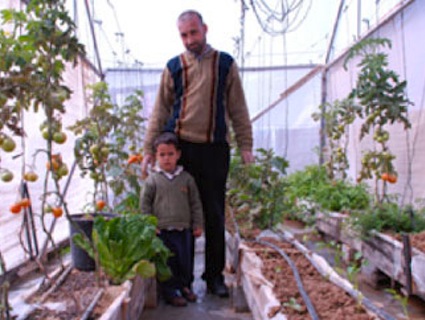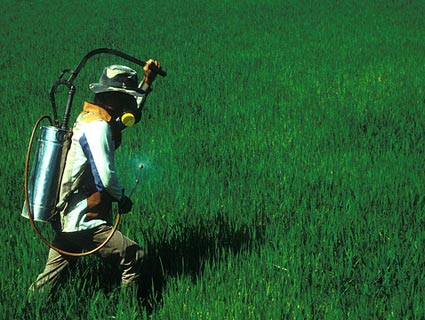
<a href="http://www.flickr.com/photos/voodoosnakes/4041220541/sizes/m/in/photostream/">Coastlander</a>/Flickr
Over the past decade and a half, as Monsanto built up its globe-spanning, multi-billion-dollar genetically modified seed empire, it made two major pitches to farmers.
The first involved weeds. Leave the weed management to us, Monsanto insisted. We’ve engineered plants that can survive our very own herbicide. Just pay up for our patented, premium-priced seeds, spray your fields with our Roundup herbicide whenever the fancy strikes, and—voilà!—no more weeds.
The second involved crop-eating insects. We’ve isolated the toxic gene of a commonly used bacterial pesticide called Bt, Monsanto announced, and spliced it directly into crops. Along with corn and soy, you will literally be growing the pesticide that protects them. Plant our seeds, and watch your crops thrive while their pests shrivel and die.
Monsanto focused its technology on three widely planted, highly subsidized crops: corn, soy, and cotton. Large-scale farmers of these commodities, always operating on razor-thin profit margins, lunged at the chance to streamline their operations by essentially outsourcing their pest management to Monsanto. And so Monsanto’s high-tech crops essentially took over the corn/soy- and cotton-growing regions of the country.
But now the pitches are wearing thin. Dumping a single herbicide onto millions of acres of farmland has, predictably enough, given rise to weeds resistant to that herbicide. Such “superweeds” are now galloping through cotton and corn country, forcing farmers to resort to highly toxic herbicide cocktails and even hand-weeding. More than 11 million acres are infested with Roundup-resistant weeds, up from 2.4 million acres in 2007, reckons Penn State University weed expert David Mortensen.
And now insects are developing resistance to Monsanto’s insecticide-infused crops, reports the Wall Street Journal. Fields planted in Monsanto’s Bt corn in some areas of the Midwest are showing damage from the corn rootworm—the very species targeted by Monsanto’s engineered trait. An Iowa State University scientist has conclusively identified Bt-resistant root worms in four Iowa fields, the Journal reports.
The findings are not likely isolated to those fields—just like spotting a cockroach on your kitchen floor probably signals an infestation, not that a lone cockroach randomly stumbled in for a visit. Sure enough, farmers in Illinois are also seeing severe rootworm damage in fields planted in Monsanto’s Bt corn. And it’s not just in the United States: In 2010, Monsanto itself acknowledged that in industrial-agriculture regions of India, where Monsanto’s Bt cotton is a dominant crop, a cotton-attacking pest called the bollworm had developed resistance.
Just as Roundup-resistant superweeds rapidly bloomed into a major problem after first appearing in the mid-2000s, Bt-resistant superinsects may be just getting started. Colleen Scherer, managing editor of the industrial-ag trade magazine Ag Professional, put it like this: “There is no ‘putting the genie back in the bottle,’ and resistance in these areas is a problem that won’t go away.”
So what does all of this mean for Monsanto? If its main attraction for farmers—the promise of easy pest management—is turning to dust in a quite public way, should we expect the company be on the verge of getting crushed under the weight of its failures?
To get a glimpse of how the publicly traded company is faring, I looked at how its stock has been performing over the past year, compared to the broader stock market. Early Monday afternoon, Monsanto’s shares were trading at about $71—a more than 25 percent gain over the past 12 months. Over the same period, the S&P 500—a broad gauge of US stocks—is up just over 10 percent. That means investors have high hopes for Monsanto going forward, despite the high-profile failures. Like weeds and bugs in farm fields, Monsanto shares have developed resistance to toxic tidings.
What gives? The Wall Street Journal article provides a clue:
The [Bt-resistance] finding adds fuel to the race among crop biotechnology rivals to locate the next generation of genes that can protect plants from insects. Scientists at Monsanto and Syngenta AG of Basel, Switzerland, are already researching how to use a medical breakthrough called RNA interference to, among other things, make crops deadly for insects to eat. If this works, a bug munching on such a plant could ingest genetic code that turns off one of its essential genes.
In other words, Monsanto claims it has the answer to the trouble it’s cooking up on corn, soy, and cotton fields: more patent-protected GM technology. It has managed to shove US farmers on a kind of accelerating treadmill: the need to apply ever more, and ever more novel, high-tech responses to keep up with ever-evolving pests. And while farmers run ever faster to stay in place, Monsanto just keeps coming up with highly profitable “solutions” to the problems it has generated.
Investors have embraced Monsanto’s pitch. Large-scale farmers, battered and desperate for relief, probably will too. But the broader citizenry, in the form of the regulatory agencies that ostensibly guard the public interest, should start asking hard questions.
















